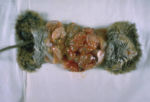Difference between revisions of "Echinococcus multilocularis"
| Line 56: | Line 56: | ||
[[Category:Zoonoses]] | [[Category:Zoonoses]] | ||
[[Category:To_Do_-_NickJ]] | [[Category:To_Do_-_NickJ]] | ||
| + | |||
| + | [[Category:To_Do_-_Review]] | ||
Revision as of 12:03, 6 August 2010
| This article is still under construction. |
| Echinococcus multilocularis | |
|---|---|
| Kingdom | Animalia |
| Phylum | Platyhelminthes |
| Class | Cestoda |
| Sub-class | Eucestoda |
| Order | Cyclophyllidea |
| Family | Taeniidae |
| Genus | Echinococcus |
| Species | E. multilocularis |
| Also known as: | Dwarf fox tapeworm |
| Causative agent of: | Alveolar Hydatid Disaese |
Overview
E. multilocularis is not present in the UK but is endemic in central Europe and North America. It is zoonotic and so presents a major health problem in Europe (including Switzerland where urabn foxes are now infected) haveing spread from 4 countries in the 1980s to being found in 12 countries now. This has been attributed to the anti-rabies campaign which has increased the number of foxes which are commonly found as the definitive host. Humans can act as intermediate hosts if eggs are ingested causing the formation of hydatid cysts in the liver, these rapidly invade the liver and are inoperable.
Characteristics
E. mulitlocularis is a relatively small tapeworm between 2-4mm as an adult.
Scolex
- 2 rows of hooks
- 4 suckers
Proglottid
- Between 3 - 5 segments in total
- Terminal proglottid forms 1/2 the length of the mature worm
- 1 proglottid shed per week
- Has single genital pore
Eggs
- 200-300 eggs per mature proglottid
- 30-40μm in diameter
- Striated shell
- Hooks visible on oncosphere
Life Cylce
E. multliocularis has a typical cestode life cycle involving the formation of a metacestode cyst in the intermediate host before developing to adulthood in the definitive host. The definitive host for E. multliocularis is most commonly the dog, though it has also been seen in the cat. Epedimiologically the most important definitive host in the spread of the disease is the fox. E. multliocularis mainly uses small rodents such as voles, mice and rats as an intermediate host, forming multilobular hydatis cysts in the liver of the host. The short life span of the intermediate host species is the reason for the rapid growth of the cyst, even in longer lived host like humans. This is the stage that generally causes pathology in the host animal and can be fatal.
Epidemiology
E. mulitilocularis is found throughout the northern hemisphere, originally its primary range was the tundra of northern Russia and eastern Europe. The prevalence of this worm is increasing to encompass many urban areas which increases the risk of zoonotic infection. The parasites definitive host in the wild is the red fox and the arctic fox. In North America and Europe there is an increasing presence of red foxes in urban and suburban areas, this increases the risk of infection of both humans and pets.
Treatment and Control
Control involves treatment of definitive hosts, dogs and cats, with anthelmintics in order to remove adult worms from the host. The treatment of intermediate host pets is not routine and can be dangerous as due to the infiltrative nature of the hydatid cyst. In humans and intermediate hosts surgical removal of the cyst is not advisable due to the infiltrative nature of the cyst and metastatic ability.
